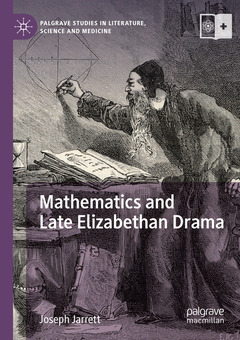Description
Mathematics and Late Elizabethan Drama, 1st ed. 2019
Palgrave Studies in Literature, Science and Medicine Series
Language: English
Subjects for Mathematics and Late Elizabethan Drama:
Mathematics and Late Elizabethan Drama
Publication date: 01-2021
242 p. · 14.8x21 cm · Paperback
Publication date: 01-2021
242 p. · 14.8x21 cm · Paperback
Mathematics and Late Elizabethan Drama
Publication date: 12-2019
242 p. · 14.8x21 cm · Hardback
Publication date: 12-2019
242 p. · 14.8x21 cm · Hardback
Description
/li>Contents
/li>Biography
/li>Comment
/li>
This book considers the influence that sixteenth-century and early seventeenth-century mathematical thinking exerted on the writing and production of popular drama between about 1587 and 1603. It concentrates upon six plays by five early modern dramatists: Tamburlaine, Part 1 (1587) and Tamburlaine, Part 2 (1587) by Christopher Marlowe; Friar Bacon and Friar Bungay (1589) by Robert Greene; Old Fortunatus (1599) by Thomas Dekker; Hamlet (1600) by William Shakespeare; and The Tragedy of Hoffman (1603) by Henry Chettle. Each chapter analyses how the terms, concepts, and implications of contemporary mathematics impacted upon these plays? vocabularies, forms, and aesthetic and dramaturgical effects and affects.
-1. Introduction.- 2. Algebra and the Art of War: Marlowe’s Tamburlaine 1 and 2 .- 3. ‘Magic, and the Mathematic Rules’: Greene’s Friar Bacon and Friar Bungay.- 4. Circular Geometries: Dekker’s Old Fortunatus.- 5. Infinities and Infinitesimals: Shakespeare’s Hamlet.- 6. Quantifying Death, Calculating Revenge: Chettle’s Tragedy of Hoffman.- 7. Conclusion.
Joseph Jarrett is currently a Lumley Junior Research Fellow at Magdalene College, University of Cambridge, UK.
First book to examine the influence that sixteenth-century and early seventeenth-century mathematical thinking exerted on the writing and production of early modern drama Examines how how the terms, concepts, and implications of early modern mathematics impacted upon plays’ vocabularies, forms, and aesthetic and dramaturgical effects and affects Focuses analysis on six key plays from five key early modern dramatists
© 2024 LAVOISIER S.A.S.

